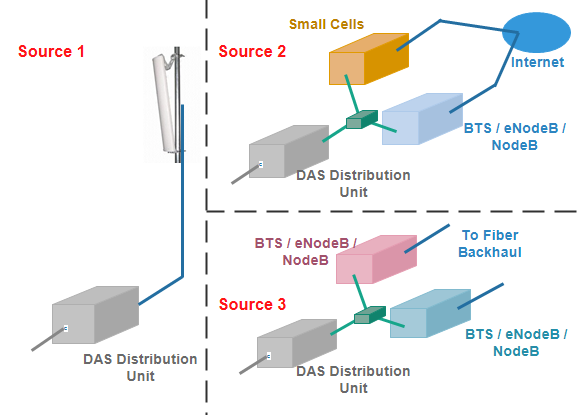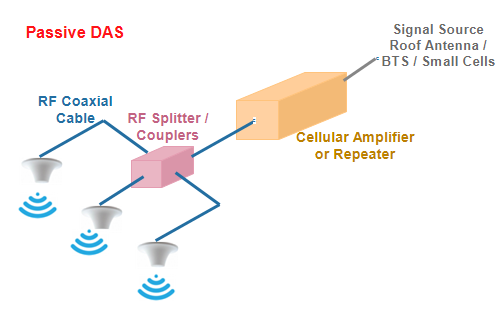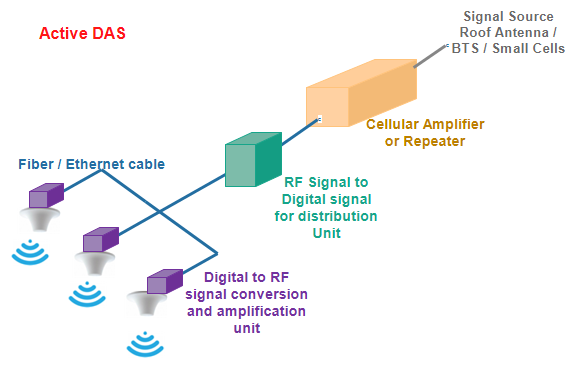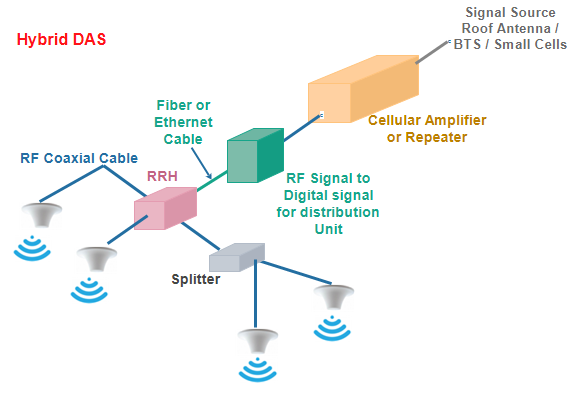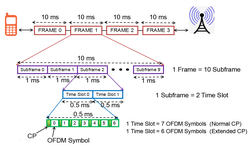Distributed Antenna System (DAS) Concept, Its Types and Benefits
According to the DAS Forum Definition, a Distributed Antenna System, or DAS, is “a network of spatially separated antenna nodes connected to a common source via transport medium that provides wireless service within a geographic area or structure”.
A distributed antenna system may be deployed indoors (an iDAS) or outdoors (an oDAS).
DAS Concept
The idea is to split the transmitted power among several antenna elements, separated in space so as to provide coverage over the same area as a single antenna but with reduced total power and improved reliability. A single antenna radiating at high power is replaced by a group of low-power antennas to cover the same area.
A DAS is a network of antennas that sends and receives cellular signals on a carrier’s licensed frequencies, thereby improving voice and data connectivity for end users. In its most simplified form, a DAS has two basic components:
1 – Signal Source
A Distributed Antenna System, as the name implies, “distributes” signal. But it generally doesn’t generate the cellular signal itself. A DAS needs to be fed signal from somewhere. This signal sources may be off-air (via an antenna on the roof), or an on-site BTS (Base Transceiver Station), or small cell.
2 – Distribution System
Once received, the cellular signal must be distributed throughout the building. A distributed antenna system can be implemented using passive splitters and feeders, or active-repeater amplifiers can be included to overcome the feeder losses.
DAS Signal Source Types
The signal sources for a DAS system are one of the single most important factors in determining both the coverage area and capacity. No matter how well the distribution system performs, a DAS is always limited by the performance of the signal supplying the network. The three main signal sources are off-air (Source 1); small cells (Source 2); and BTS, NodeB or eNodeB (Source 3), shown in below image.
DAS Signal Distribution Types
Passive DAS
In Passive DAS, the signal source (which is BTS outsite or Antenna on the roof) connects to a cellular amplififer or repeater, which then connects to the distributed antenna around the building or facility using coaxial cable and splitters, where appropriate. There is no amplification between the repeater and the distributed antennas, hence the name passive distributed antenna system.
There are limitations to the reach of passive DAS solutions. Because they use coax cable to distribute signal, signal loss is higher than with active DAS. The further away the antennas are from the amplifier, the higher the signal loss. The signal loss results in lower downlink output power.
But the advantages of passive DAS solutions are considerable. In particular, they are considerably cheaper than active DAS. Because they typically rebroadcast the macro network’s signal, there is less need for carrier approval and coordination.
Active DAS
Active DAS employ amplifiers at the distributed antenna locations, and signals may be transported from the repeater to the distributed antenna locations via fiber, or CAT-5/6 cabling. The amplifiers amplify the signal from the repeater and provide a stronger signal to wireless units. They also amplify signals from the wireless units to provide a stronger outgoing signal. Active DASs may cover very large areas, but at the expense of higher cost and greater complexity.
Hybrid DAS
A hybrid DAS combines characteristics of passive and active systems. . Hybrid DAS uses some fiber for distribution of signal, but relies on passive coaxial cable for much of the signal distribution. The RRUs are separate from the antennas, allowing the system to use both fiber optic cable and coaxial cable to distribute signal throughout a building. Hybrid systems can be a good solution for medium-sized spaces, or unusual signal problems. Multiple passive systems can be linked by fiber cable to a remote amplifier unit.
What are the advantages of a DAS ?
- Coverage: DAS architecture provides coverage in areas that cannot be effectively addressed with traditional sites. And it helps overcome the shadowing and penetration losses because a line of sight link is available more frequently. As a result the levels of absorption are lower and this means coverage is increased,
- Capacity: DAS can closely align capacity to actual market requirements, managing available radio resources.
- Spectrum: DAS uses available frequency spectrum efficiently through multiple low-power transmission points.
- Interference: DAS reduces interference through low radiation centers and lower output power.
- Data Rates: DAS provides better data throughput given signal strength and proximity of transmission points to user equipment.
- Scalability: DAS is a scalable network that can meet future capacity requirements, or additional carriers, by adding additional nodes.
- Adaptability: DAS can respond to market dynamics, equipment architecture changes and new technologies.

